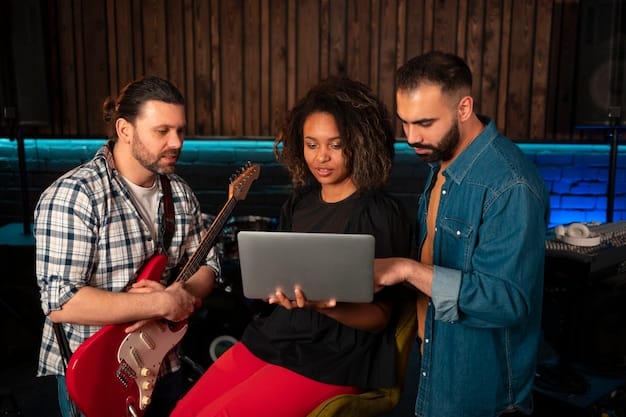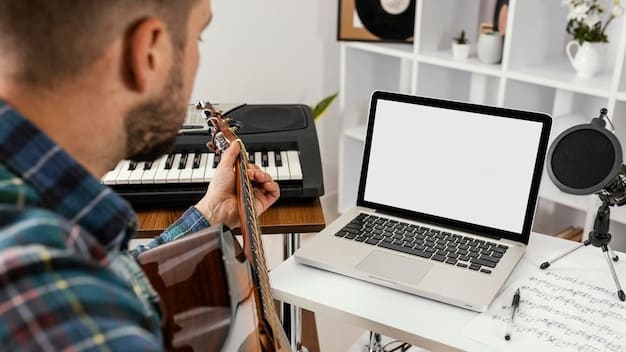Get Your Music Heard: Ultimate Guide for Emerging Artists to Playlist Success

Emerging Artists: How to Get Your Music Featured on Popular Playlists – Insider Tips offers a practical roadmap for musicians seeking to boost their visibility by leveraging the power of playlist placements, offering strategies, tips, and insights to help them navigate the world of music curation.
For emerging artists, getting your music heard can feel like an uphill battle. One of the most effective ways to break through the noise is to land your tracks on popular playlists. This article, Emerging Artists: How to Get Your Music Featured on Popular Playlists – Insider Tips, gives you actionable strategies to make it happen.
Understanding the Playlist Landscape
Playlists have become the new radio, wielding significant power in shaping music discovery and boosting an artist’s reach. Understanding how the playlist ecosystem works is the first step for any emerging artist striving for playlist placement.
The Importance of Playlists
Playlists aren’t just collections of songs; they are curated experiences that cater to specific moods, genres, or activities. Getting your music on the right playlist can expose it to a massive audience that aligns with your style, leading to increased streams, followers, and recognition.
Understanding the different types of playlists available, and how they are curated, is crucial to targeting the right ones for your music.
Types of Playlists to Target
There are generally three primary types of playlists:
- Editorial Playlists: These are created and managed by music platforms like Spotify, Apple Music, and Amazon Music. Landing on these playlists can provide a tremendous boost in exposure.
- Algorithmic Playlists: These are generated by algorithms based on user listening habits and preferences. Being included in these playlists means your music is resonating with listeners already.
- User-Generated Playlists: These are created by individual users, influencers, or brands. While their reach may vary, they can be highly influential within specific communities.

Understanding these different playlist types allows artists to effectively tailor their submission strategies, targeting curators and playlists that are most receptive to their music.
Crafting Music That Fits Playlists
While promotion is crucial, the foundation of playlist success lies within the music itself. Ensure your music is playlist-ready by paying close attention to production quality, song structure, and genre alignment.
High-Quality Production
In today’s competitive music landscape, high-quality production is non-negotiable. Clear, well-mixed, and mastered tracks stand a much better chance of catching a curator’s ear. Invest in good equipment or consider working with a professional mixing and mastering engineer.
Ensure your music stands out sonically and captures the attention of playlist curators and listeners alike.
Song Structure and Engagement
Curators often make snap decisions about whether a song is right for their playlist in the first few seconds. Make sure your song grabs the listener’s attention quickly, with a catchy hook, engaging intro, or compelling vocal.
A well-structured song that keeps listeners engaged from start to finish significantly increases its chances of being added to a playlist.
- Start Strong: The intro should be captivating from the first few seconds.
- Dynamic Structure: Keep the arrangement interesting with varied sections.
- Memorable Hook: A catchy chorus or instrumental hook is essential.
Paying careful attention to these elements can greatly increase the likelihood of your song getting added to a relevant playlist.
Finding the Right Playlists and Curators
Identifying the appropriate playlists and curators is a vital aspect of playlist promotion. Aim to align your music with playlists that complement your genre, mood, and target audience.
Researching Relevant Playlists
Start by exploring playlists within your genre on major streaming platforms like Spotify, Apple Music, and Deezer. Take note of the playlist names, curator information, and the types of artists featured.
Focus your efforts on playlists with similar sounds and audience demographics to increase the odds of a successful pitch.
Tools for Playlist Discovery
Several online tools can help you discover and analyze playlists. These tools provide valuable insights into playlist follower counts, engagement rates, and curator contact information.
These tools can also help you pinpoint playlists with similar artists and sounds, enabling you to precisely target your promotion efforts.
- Chartmetric: Offers detailed playlist analytics and curator contact information.
- Soundcharts: Provides comprehensive data on music airplay, playlist placements, and social media trends.
- Playlist Miner: Helps you discover playlists based on keywords and track analytics.
These tools are invaluable for gaining insights into the playlist ecosystem and identifying potential targets.
Crafting an Effective Pitch
Crafting a compelling pitch is essential to captivate music curators. Your pitch needs to be concise, respectful, and personalized, showcasing why your music is the ideal fit for their playlist.
Personalization is Key
Avoid generic, copy-pasted pitches. Instead, take the time to research the curator and their playlists. Mention specific tracks that resonate with you and explain how your music aligns with the playlist’s theme and style.
A personalized pitch demonstrates genuine interest, increasing the odds of catching the curator’s attention.
Highlight Your Unique Selling Points
What makes your music stand out? Whether it’s a unique sound, compelling lyrics, or a strong fanbase, emphasize what distinguishes you from other artists. Showcase your accomplishments and previous successes to establish credibility.
Include metrics if available, such as social media following, previous streaming numbers, or any press recognition you have received.

Building Relationships with Curators
Building lasting relationships with playlist curators can significantly boost your long-term success. Engage with curators on social media, attend industry events, and foster meaningful connections.
Social Media Engagement
Follow curators on social media platforms like Twitter, Instagram, and LinkedIn. Like, comment, and share their posts, demonstrating your support for their work. Engage in meaningful conversations and offer genuine feedback on their playlists.
Building rapport on social media can pave the way for more personalized and effective communication.
Attending Industry Events
Attend music industry conferences, showcases, and networking events to meet curators in person. Introduce yourself, share your music, and engage in conversations about their playlists and curation process.
Face-to-face interactions can create lasting impressions and strengthen relationships.
- Networking Opportunities: Attend events like SXSW, CMJ, and local music conferences.
- Showcase Performances: Perform at events where curators are likely to be in attendance.
- Follow-Up: After meeting curators, follow up with a personalized email to maintain the connection.
These opportunities can result in lasting relationships with curators.
Leveraging Data Analytics
Data analytics provide invaluable insights into how your music is performing on playlists. Analyze your streaming data, track playlist placements, and adjust your strategies based on the results.
Tracking Your Performance
Use analytics dashboards provided by streaming platforms like Spotify for Artists and Apple Music for Artists to track your streaming data. Monitor which playlists are driving the most streams, identify your top-performing songs, and analyze listener demographics.
Understanding your music’s performance on playlists is essential for refining your promotion efforts.
Optimizing Your Strategy
Use the insights gained from data analytics to optimize your playlist promotion strategy. Focus your efforts on playlists that are driving engagement, refine your pitches based on curator preferences, and experiment with different promotion tactics.
Continual analysis and adaptation are key to long-term success in the playlist ecosystem.
| Key Point | Brief Description |
|---|---|
| 🎵 Music Quality | Ensure top production and catchy song structure. |
| 🎯 Target Playlists | Research playlists in your genre and audience. |
| ✉️ Personalized Pitch | Craft individual pitches for each curator. |
| 📊 Data Analytics | Use analytics to understand your music’s playlist performance. |
FAQ
▼
Playlists are highly important. They greatly expand your music’s visibility, reaching new listeners, increasing streams, and building a dedicated fanbase. They act as modern-day radio for discovery.
▼
Explore playlists on Spotify, Apple Music, and Deezer using genre-specific keywords. Use tools like Chartmetric and Soundcharts to identify and analyze playlists and their curators.
▼
Personalize each pitch. Mention specific playlists you admire, explain the alignment of your music with their theme, and highlight your unique selling points or achievements that distinguish your music.
▼
Focus on high-quality music production, engage with your existing fanbase, and submit your music to curators well in advance of the release date through the streaming platform’s official channels.
▼
Track metrics such as number of streams, listener demographics, source playlists driving the most traffic, and overall engagement. Adjust your strategy based on these performance insights to optimize your reach.
Conclusion
Securing playlist placements is a dynamic yet essential strategy for emerging artists: how to get your music featured on popular playlists – insider tips involve a combination of understanding the playing field, refining your craft, building relationships, and leveraging data to optimize your efforts. By implementing these strategies, you’ll significantly increase your visibility and grow your fanbase.





